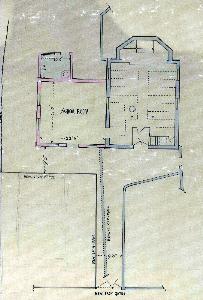![The Methodist chapel about 1900 [Z50/95/60]](/CommunityHistories/Ridgmont/RidgmontImages/The Methodist chapel about 1900 [Z50-95-60].jpg)
The Methodist chapel about 1900 [Z50/95/60]
Samuel Bennet was a member of a noted Wesleyan family, who farmed in Ridgmont in the 1840s to the early 1850s. He was self educated and aware of the importance of elementary education so he became the founder and patron of a Wesleyan day school for boys which flourished during his lifetime but declined after his death and probably closed in the early 1870s. It is unclear whether this was a formally affiliated British School or not but the first certain mention is in 1846 when the Duke of Bedford was invited to contribute [R3/5051 and 5107].
In 1833 a questionnaire had been sent to each parish in England asking for details of local educational provision. For Ridgmont it was recorded that there was one Daily School (started in1831) which taught 33 boys and 10 girls whose parents paid for their lessons. The nature of the daily school, whether Anglican, nonconformist or neither, is unclear but it may be an early reference to the Wesleyan School.
A report by J. D. Morell on British and Wesleyan schools in 1849 noted that Ridgmont was run by the Wesleyan church and catered for 52 children: "The school is situated in a village where education was deeply needed, and it has been attended hitherto with decided success. The school-room is small but more than filled. The children are of a somewhat miscellaneous description, many of them of an age rather fit for an infant school. The master has been working very diligently, and the pupil teachers, one of whom is now recommended, have rendered very essential service. The reading and arithmetic are fair; grammar and geography quite elementary. Some knowledge of history and other useful subjects is also conveyed in collective lessons. As a village school it is very satisfactory".
By 1851 the number of boys had risen to 78 which was about the limit the room could accommodate. It had improved significantly since 1849: "The mental intelligence generally is very strikingly advanced". By 1853 the numbers had climbed still further to 85: "Discipline good. Instruction fair. The master has his school in an excellent state, on the whole. The infants in this mixed school are nicely managed by the pupil teachers, but female management is much needed for them".
The Post Office Directory for Bedfordshire of 1847 does not mention any school in Ridgmont; neither does Craven & Company's directory of 1853. The Post Office Directory of 1854 only mentions the NationalSchool, created in that year. Edward Cassey & Company's Directory of 1862 again makes no mention of any school in the parish. However, The Post Office Directory for 1864 has an entry for the British School, mistress of which was Miss Elizabeth Brooks. The Post Office Directory of 1869 gives the mistress as Miss Elizabeth Summerly. The next directory, 1877, has no reference to the school and so one can conclude that it closed between 1869 and 1877.
In the Methodist archive at Bedfordshire & Luton Archives & Records Service is a plan [MB2648] for a schoolroom at the chapel. This room does not now exist and so the plan may never have been put into effect.

Ridgmont School room plans [MB2648] - to see a larger version please click on the image
In 1911, 85 High Street, today's [2012] Firs Guest House adjoining the Methodist chapel, was conveyed to the Duke of Bedford [HN10/353/Adams1]. The conveyance included a schoolroom and it seems likely that this was the former Methodist schoolroom. It was still referred to as a schoolroom in 1926 [DV1/C54/95-98]